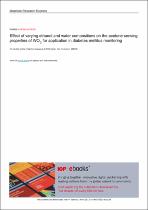 ResearchSpace
ResearchSpace
Effect of varying ethanol and water compositions on the acetone sensing properties of WO3 for application in diabetes mellitus monitoring
JavaScript is disabled for your browser. Some features of this site may not work without it.
- ResearchSpace
- →
- Research Publications/Outputs
- →
- Journal Articles
- →
- View Item
| dc.contributor.author |
Saasa, Valentine

|
|
| dc.contributor.author |
Lemmer, Yolandy

|
|
| dc.contributor.author |
Malwela, Thomas

|
|
| dc.contributor.author |
Akande, Amos A

|
|
| dc.contributor.author |
Beukes, M

|
|
| dc.contributor.author |
Mwakikunga, Bonex W

|
|
| dc.date.accessioned | 2020-10-05T09:03:48Z | |
| dc.date.available | 2020-10-05T09:03:48Z | |
| dc.date.issued | 2020-03 | |
| dc.identifier.citation | Saasa, V (et.al.) 2020. Effect of varying ethanol and water compositions on the acetone sensing properties of WO3 for application in diabetes mellitus monitoring. Materials Research Express, v7(3), 13pp. | en_US |
| dc.identifier.issn | 2053-1591 | |
| dc.identifier.uri | https://doi.org/10.1088/2053-1591/ab7d58 | |
| dc.identifier.uri | https://iopscience.iop.org/article/10.1088/2053-1591/ab7d58/meta | |
| dc.identifier.uri | http://hdl.handle.net/10204/11597 | |
| dc.description | Copyright: 2020 IOP Publishing Ltd. This is the fulltext version of the work. Original content from this work may be used under the terms of the Creative Commons Attribution 4.0 licence. Any further distribution of this work must maintain attribution to the author(s) and the title of the work, journal citation and DOI. | en_US |
| dc.description.abstract | Tungsten oxide based gas sensors have attracted a lot of attention in breath acetone analysis due to their potential in clinical diagnosis of diabetes. The major problem with this material in sensor application has been remarkable response to all gases but low selectivity to specific gases. Herein, we report the gas sensing performance of WO3 materials which were synthesized by varying water and ethanol ratios using a facile solvothermal method for acetone detection. The gas sensing properties of as-prepared WO3 were tested on acetone C7H8, NO2, NH3, H2S and CH4 under relative humidity. X-ray diffraction patterns show that as-prepared WO3 samples are mainly composed of monoclinic WO3, a phase having relatively high selectivity to acetone. The as-prepared WO3 sensors produced using 51:49 ratio of water: ethanol show an increase in acetone response as the acetone concentration increases and a decrease in acetone response as the relative humidity increases. The sensor responded to a very low acetone concentration ranging from 0.5 to 4.5 ppm which is normally found in human breath. Furthermore, the sensor exhibited high sensitivity and selectivity to low ppm of acetone at 100 °C. On contrary, the sensor showed significantly lower response to other gases tested. | en_US |
| dc.language.iso | en | en_US |
| dc.publisher | IOP Publishing Ltd | en_US |
| dc.relation.ispartofseries | Worklist;23691 | |
| dc.subject | Acetone | en_US |
| dc.subject | Gas sensors | en_US |
| dc.subject | Selectivity | en_US |
| dc.subject | Sensitivity | en_US |
| dc.subject | Tungsten trioxide | en_US |
| dc.title | Effect of varying ethanol and water compositions on the acetone sensing properties of WO3 for application in diabetes mellitus monitoring | en_US |
| dc.type | Article | en_US |
| dc.identifier.apacitation | Saasa, V., Lemmer, Y., Malwela, T., Akande, A. A., Beukes, M., & Mwakikunga, B. W. (2020). Effect of varying ethanol and water compositions on the acetone sensing properties of WO3 for application in diabetes mellitus monitoring. http://hdl.handle.net/10204/11597 | en_ZA |
| dc.identifier.chicagocitation | Saasa, Valentine, Yolandy Lemmer, Thomas Malwela, Amos A Akande, M Beukes, and Bonex W Mwakikunga "Effect of varying ethanol and water compositions on the acetone sensing properties of WO3 for application in diabetes mellitus monitoring." (2020) http://hdl.handle.net/10204/11597 | en_ZA |
| dc.identifier.vancouvercitation | Saasa V, Lemmer Y, Malwela T, Akande AA, Beukes M, Mwakikunga BW. Effect of varying ethanol and water compositions on the acetone sensing properties of WO3 for application in diabetes mellitus monitoring. 2020; http://hdl.handle.net/10204/11597. | en_ZA |
| dc.identifier.ris | TY - Article AU - Saasa, Valentine AU - Lemmer, Yolandy AU - Malwela, Thomas AU - Akande, Amos A AU - Beukes, M AU - Mwakikunga, Bonex W AB - Tungsten oxide based gas sensors have attracted a lot of attention in breath acetone analysis due to their potential in clinical diagnosis of diabetes. The major problem with this material in sensor application has been remarkable response to all gases but low selectivity to specific gases. Herein, we report the gas sensing performance of WO3 materials which were synthesized by varying water and ethanol ratios using a facile solvothermal method for acetone detection. The gas sensing properties of as-prepared WO3 were tested on acetone C7H8, NO2, NH3, H2S and CH4 under relative humidity. X-ray diffraction patterns show that as-prepared WO3 samples are mainly composed of monoclinic WO3, a phase having relatively high selectivity to acetone. The as-prepared WO3 sensors produced using 51:49 ratio of water: ethanol show an increase in acetone response as the acetone concentration increases and a decrease in acetone response as the relative humidity increases. The sensor responded to a very low acetone concentration ranging from 0.5 to 4.5 ppm which is normally found in human breath. Furthermore, the sensor exhibited high sensitivity and selectivity to low ppm of acetone at 100 °C. On contrary, the sensor showed significantly lower response to other gases tested. DA - 2020-03 DB - ResearchSpace DP - CSIR KW - Acetone KW - Gas sensors KW - Selectivity KW - Sensitivity KW - Tungsten trioxide LK - https://researchspace.csir.co.za PY - 2020 SM - 2053-1591 T1 - Effect of varying ethanol and water compositions on the acetone sensing properties of WO3 for application in diabetes mellitus monitoring TI - Effect of varying ethanol and water compositions on the acetone sensing properties of WO3 for application in diabetes mellitus monitoring UR - http://hdl.handle.net/10204/11597 ER - | en_ZA |





